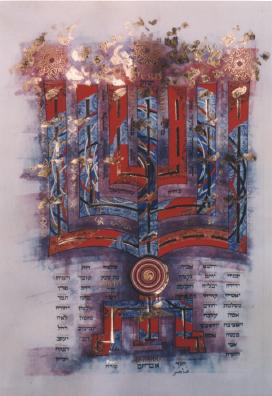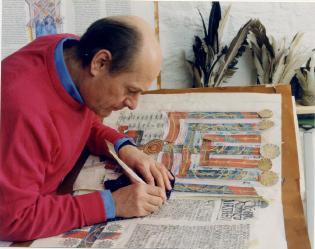


|
Books
as Art
These days it seems we are drowning in printed material of all kinds. Books and magazines are both affordable and accessible. They can be purchased in new bookstores, used bookstores, online web sites, through book club memberships, and more recently, even downloaded to your personal computer as e-matter. But this degree of availability was not always the case with books. Prior to the technological wonder of the printing press, book ownership during the Middle Ages was quite different. Books (manuscripts) were highly valued not only for their content, but also for the laborious process of their production-each book was hand made using animal skin (vellum) and a quill. Whether by monks or by laymen every letter and decoration had to be carefully placed on the page. Even though booksellers often utilized several scribes and artists (illuminators) to create their books, the production process was extremely slow. Medieval books were also incredibly expensive, exceptionally meaningful, and at times, deeply personal. It is important to keep in mind that the medieval population was not surrounded by images as we are now. As a result, each image and written word was special to the owner alone. Although many centuries have passed since the painstaking creation of medieval manuscripts, the technique and materials have experienced renewed interest. Tucked away in a scriptorium in Wales, a team of artists and calligraphers has recently begun creating the first hand written and decorated Bible since the printing press was invented over 500 years ago. Commissioned by the Benedictine monks at St. John's University in Minnesota, The Saint John's Bible is sure to be a marvel of illuminated manuscripts.
The planned seven-volume Bible will measure 23 ½ x 15 ¾ inches and will include The Gospels and the Acts of the Apostles, The Book of Psalms, The Pentateuch, The Wisdom and Poetic Books, The Prophets, The Historical Books, and The Letters and The Book of Revelation. The text will be written entirely by hand using a goose quill on calfskin vellum, and the illustrations (illuminations) will be made with gold, silver, copper and platinum. However, apart from its adherence to medieval book production practices, The Saint John's Bible is very much a Bible for the new millennium. Instead of a Latin text, an English translation will be used. And rather than relying on traditional illustrations to interpret scripture, The Saint John's Bible reflects a contemporary multicultural society far removed from its medieval predecessors. The illuminations will include imagery from other sources such as science, Eastern religious traditions, Native Americans, as well as incorporating the flora and fauna of Minnesota.
After two years of meticulous preparation, Welsh artist Donald Jackson has placed the first word on the first page of the new Bible. "The Bible is the calligraphic artist's supreme challenge, our Sistine Chapel," said Jackson. There is little doubt that Mr. Jackson is more than aware of the enormous scale of this project. And by means of 21st century technology, this highly anticipated moment was videotaped and is now available on the Saint John's web site. The completion of the first volume is expected by Christmas 2000 and the entire project will be finished in 2004. No doubt this project is expected to cost millions of dollars, but it is being funded only through private financial support. In the age of information overload, it might be quite refreshing to discover how deeply meaningful a book can be. So why not take some time to explore this web site and learn more about how books were made and why the medieval practice of book making should be considered more than just mere craftsmanship, it is also a genuine form of art. |

